
Why The Sun Isn’t Causing Climate Change
The sun is the primary driver of Earth’s climate, and so when the climate changes, it’s a good idea to find out if the sun is the cause. After all, the sun provides the Earth with almost all of its heat, and Earth’s average temperature is currently increasing. Currently, it is widely accepted by the scientific community that human-induced greenhouse warming is the cause of current climate change, yet a common misconception is that the sun is the true cause. How do we know the sun is not causing climate change?
Solar Heating vs Greenhouse Warming

There are simple ways of finding out whether the sun is causing current climate change or not. If the sun is the cause of warming and not human produced greenhouse gases, we should expect to see a particular type of warming. When the sun increases its solar output, the incoming energy heats up Earth’s outer atmosphere atmosphere. Heat from the sun will gradually warm the outer atmosphere by a higher margin than the lower atmosphere, and so if the sun is causing Earth’s temperature to increase, this is the warming pattern we should expect to observe. This form of heating is an entirely different kind of warming than what is induced by the greenhouse effect. If the greenhouse effect is to blame, then we should observe warming in the lower parts of the atmosphere and cooling in the upper atmosphere, exactly opposite of solar warming. This is because greenhouse gases trap heat from the sun near the surface. From both weather stations and satellites, scientists have measured the temperatures in the lower and upper atmosphere to a very high precision, and have found that, while the lower atmosphere has been increasing in temperature, the upper atmosphere has been getting colder, exactly what is expected from greenhouse warming. This is one observation supporting greenhouse warming over solar warming.
Cosmic Rays

Another observation can be done regarding solar output itself, and whether or not it has been increasing over time. One way to do this is to measure the amount of cosmic rays coming into our atmosphere. When solar output is high, the number of cosmic rays entering our atmosphere goes down as the solar wind pushes them away. When solar activity decreases, the amount of cosmic rays increases. Cosmic rays are a form of radiation that comes from interstellar space, far outside the boundaries of our solar system. When the sun emits radiation, it pushes cosmic rays away from the planets, and so when the sun is more active, there are less cosmic rays hitting our planet. Scientists have measured very precisely the amount of cosmic rays entering the atmosphere and have found something interesting: the amount of cosmic rays has been increasing with time. This means that solar activity has been decreasing. Furthermore, solar observations have revealed a cooling trend in solar temperatures, agreeing with the observation that cosmic rays are increasing as well. After years of studying the sun, there is no evidence that the sun is the cause of current climate change.











